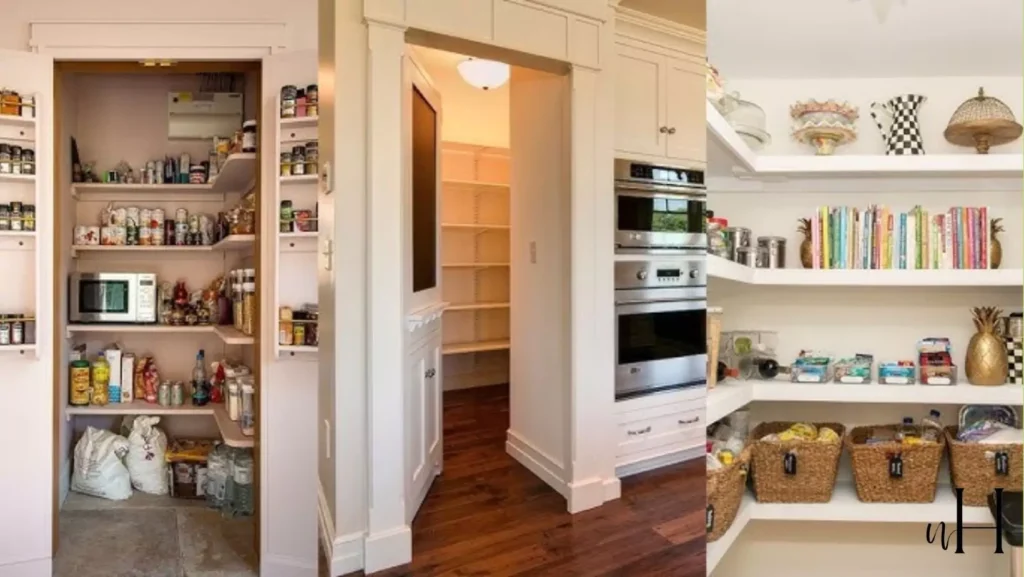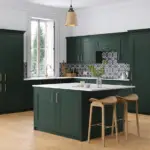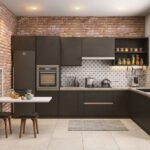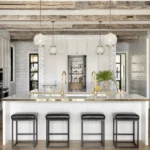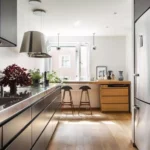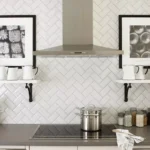A well-organized pantry doesn’t just make cooking easier – it transforms the way your kitchen feels and functions. Before this I skilled the categorization of pantry that helped me alot in my daily chores.
How to Organize Pantry by Category-11 Efficient Tips to Level Up Your Pantry
Whether you’re working with a narrow closet, a full walk-in, or simply a spare cabinet, the right shelving and layout can maximize every inch of space while keeping things neat and stylish.
From classic white wire shelves to rustic wood planks, hidden cabinets, and even pantries with rolling ladders, there are countless ways to design storage that fits your home and lifestyle.
These are all the designs for a small walk-in pantry that I used at my home I also saw in my friends’ homes, as you know home decor enthusiasts always look for new ideas.
In this guide, I will tell you smart pantry ideas – from space-saving tricks to design-forward options – that will help you keep everything in its place without sacrificing beauty or convenience.
1. White Metal Wire Shelves
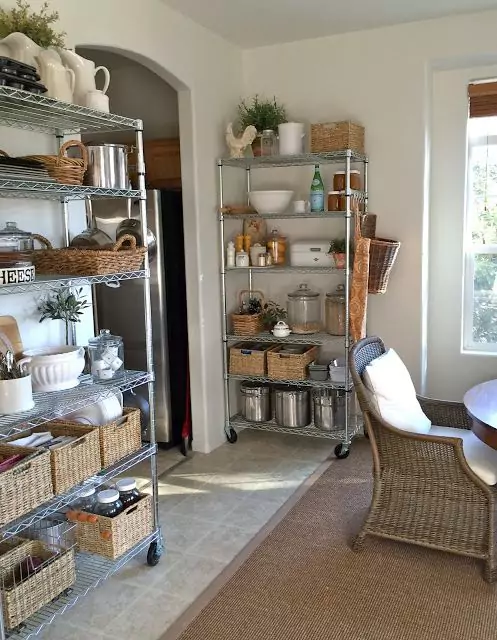
White wire shelving provides lightweight, open storage that keeps items visible and the pantry airy. Lily Ann Cabinets notes that white metal wire shelves are “sturdy and durable” yet easy to install, making them ideal for heavy groceries on a budget.
The open grid lets light pass through, and white paint brightens the space.
Use baskets or clear containers on the shelves to corral items by category. This shelf-only layout maximizes every inch of wall and works especially well in very narrow pantries.
2. Built-In Open Shelves
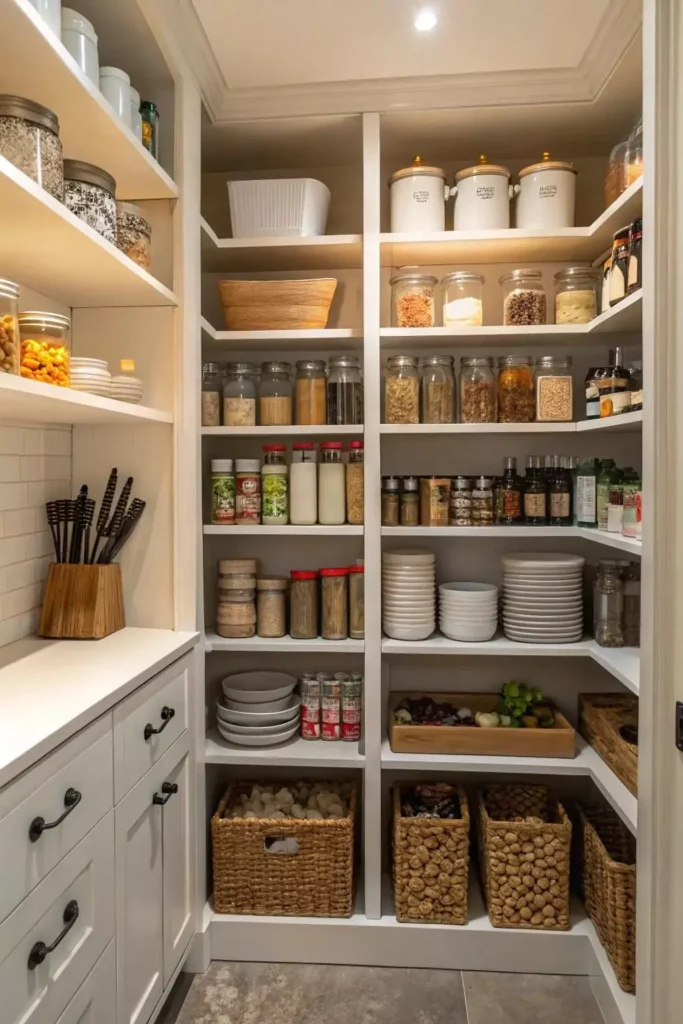
Floor-to-ceiling built-in shelves painted white create a clean, bright pantry backdrop. As Lily Ann points out, white built-in shelving gives a “clean and fresh look” while using every nook, including corners, so no space is wasted.
You can vary shelf heights for large and small items, and leave some shelves open for frequently used items.
For a polished look, trim the shelves with molding. Organization tip: place like-items together on open shelves (e.g. baking goods on one shelf, canned items on another) and use labeled bins or baskets for loose goods.
3. Rustic Wood Shelves (Farmhouse Style)
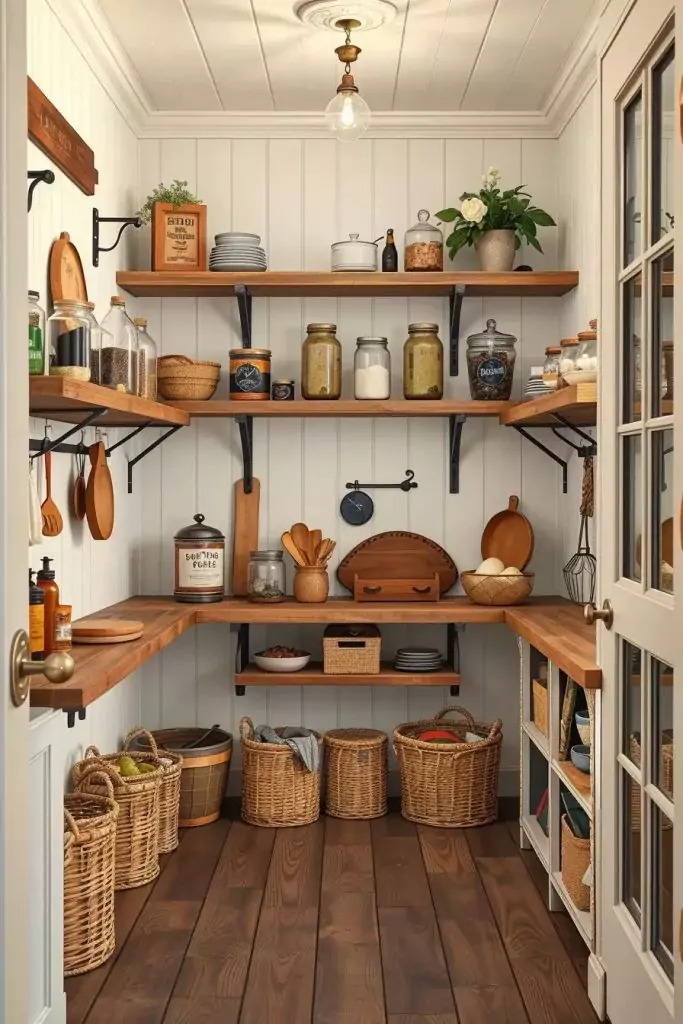
Stained wood shelves bring a warm, farmhouse vibe to a pantry. The natural wood grain adds “character and authenticity” and a cozy feel. Use thicker wood planks or rustic reclaimed boards to support heavy items; treat the wood to resist moisture.
This shelf-only design pairs nicely with glass jars, burlap bins, and vintage labels.
An organizational tip: mix wood shelves with matching baskets or mason jars (for grains, pasta, beans) – the clear containers let you see contents at a glance, while the wood adds an appealing contrast and durability.
4. Shelves with Woven Baskets
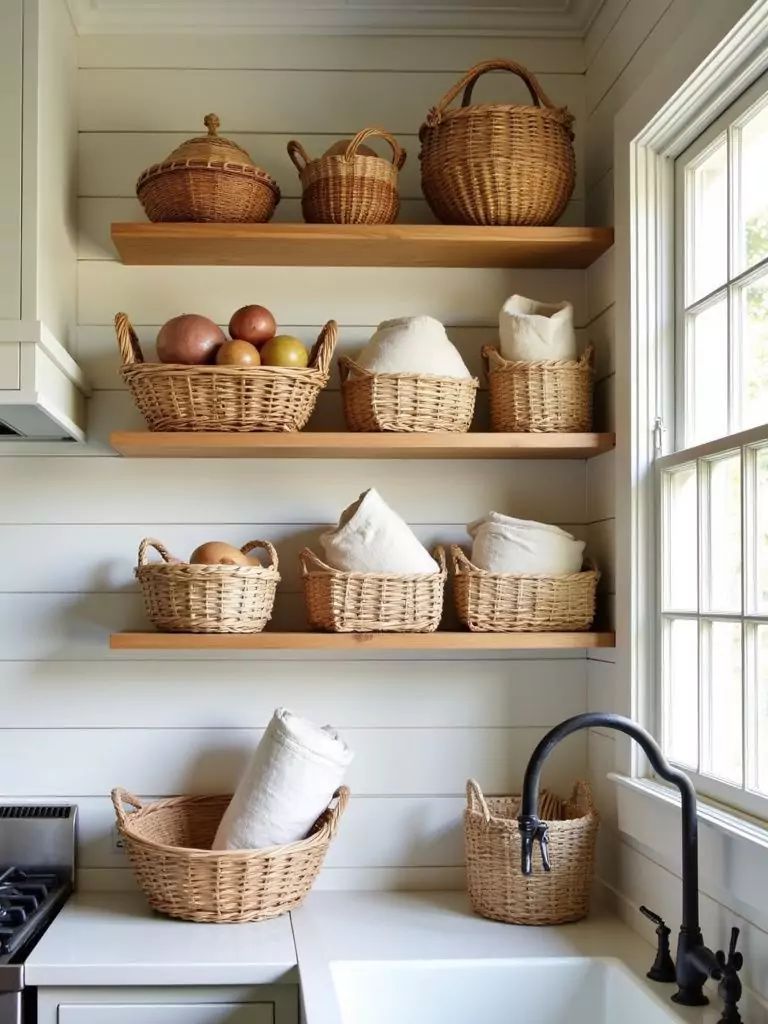
Add texture and softness by placing woven baskets on the pantry shelves. White or wood shelves combined with natural-fiber baskets create visual interest and a tidy look.
Baskets are perfect for holding bulky or oddly shaped items (kids’ snacks, linens, produce). Label each basket so everyone knows what’s inside.
This shelf-plus-basket setup keeps pantry fronts neat – pull out the basket you need, then slide it back in to hide clutter. Using a uniform basket style (size/color) also keeps the aesthetic cohesive.
5. U-Shaped Pantry Layout
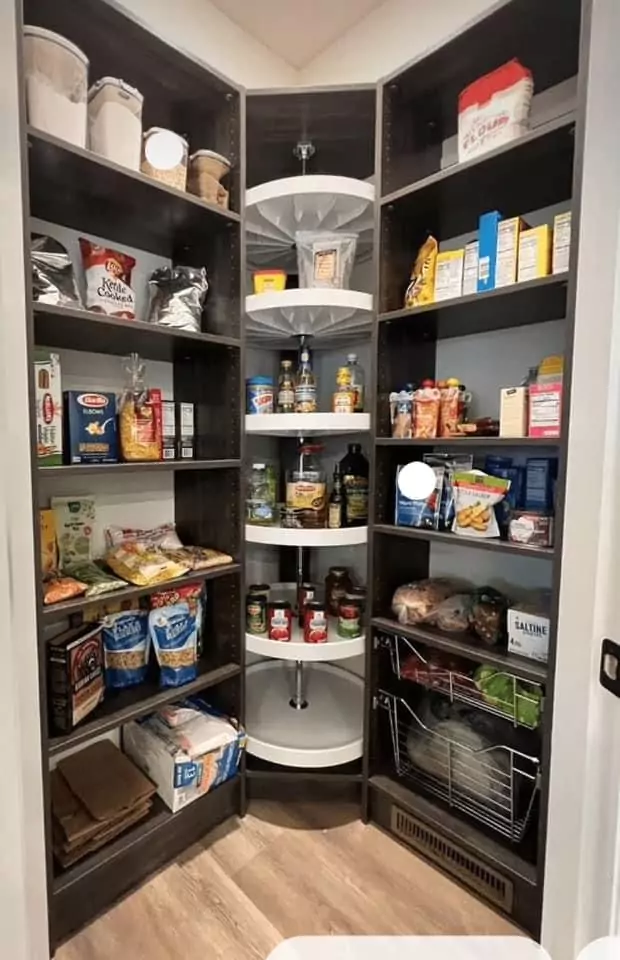
A U-shaped layout wraps shelves or cabinets around three walls, maximizing storage. Lily Ann explains that a U-shaped pantry can include countertops on each wall for prep or appliances.
In practice, this means one wall might have floor-to-ceiling cabinets, a second wall could have open shelves above and cabinets below, and the third might host a countertop with drawers.
The result is a compact “kitchen within a kitchen.” To organize, dedicate each wall to a function (e.g. baking supplies one side, everyday foods opposite) so you can work from one side to the other efficiently.
6. L-Shaped Wraparound Shelving
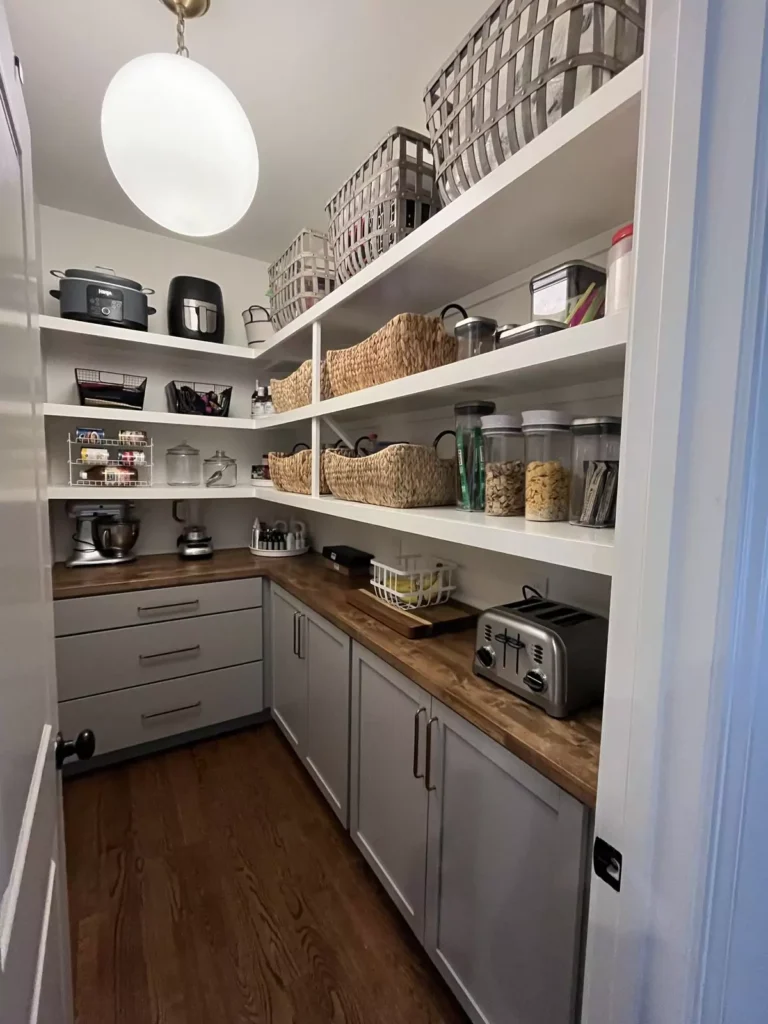
Install shelves on two adjacent walls in an L-shape for continuous storage. As Lily Ann notes, a wrap-around shelving system “maximizes the available space along the walls”.
This design eliminates awkward corners by extending shelves seamlessly around the turn. You might have deep shelves on one longer wall and shorter ones on the perpendicular wall.
Keep the L-shape organized by grouping items on each wall (for example, breakfast foods on one side, snacks on the other). Open shelves on two walls provide plenty of room while keeping the pantry uncluttered.
7. Sliding Barn Door Pantry
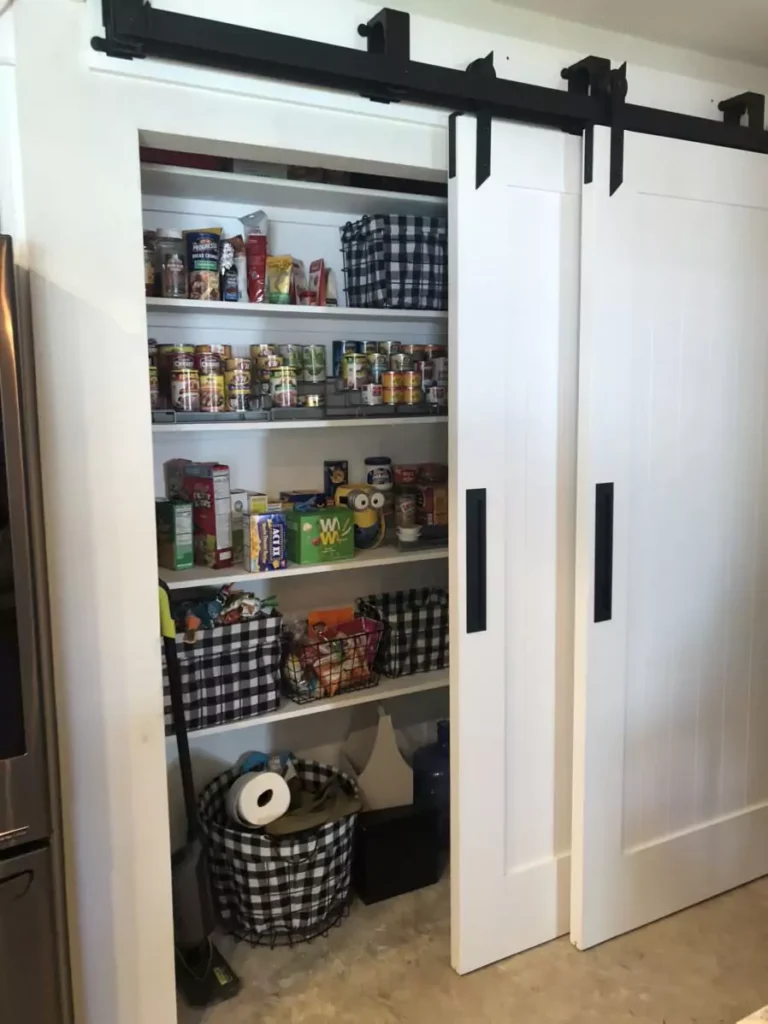
Use a sliding barn door as the pantry entrance to save space and add character. A barn door “slides along the wall, eliminating the need for extra space to accommodate the door’s swing”.
Choose a rustic wood finish or paint to match your kitchen décor. This door becomes a focal point – for instance, a distressed wood door against white cabinets looks charming. Functionally, barn doors are great in tight kitchens.
You can also install a handle or chalkboard panel on the door for shopping lists or pantry notes without sacrificing space.
8. Hidden Cabinet Pantry
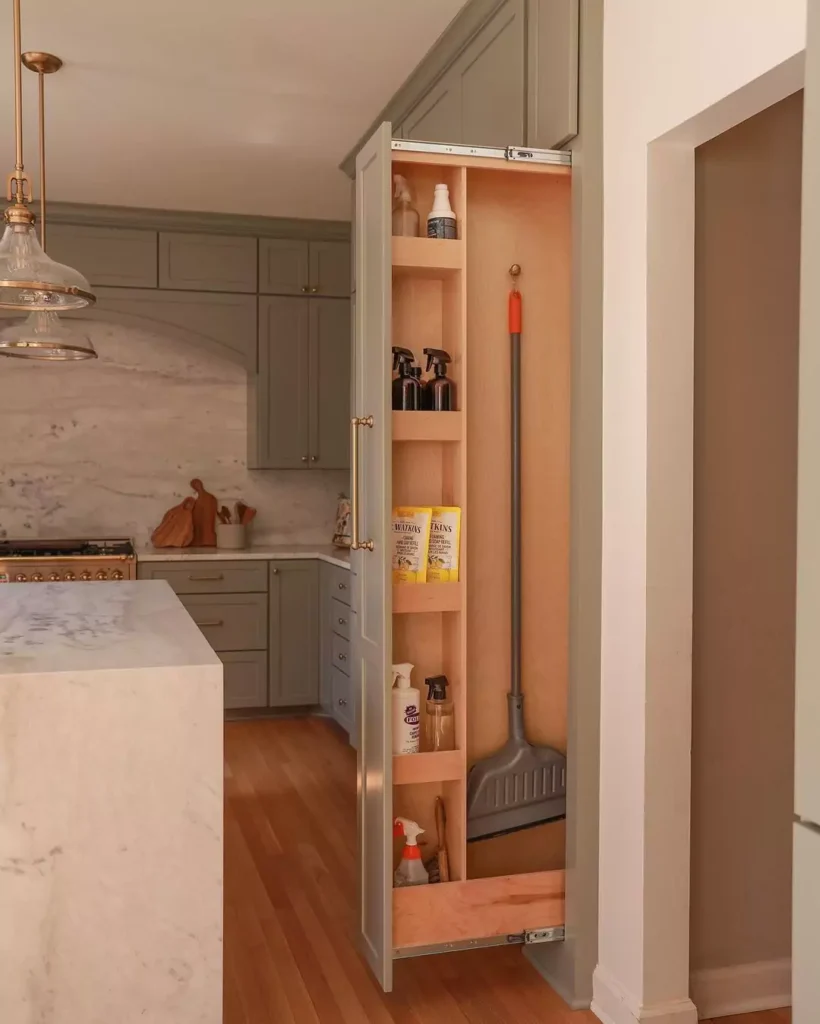
Hide the pantry behind cabinet doors for a seamless look. One BHG design recommends using upper cabinet doors that blend into the kitchen “to reveal the pantry” once opened.
The pantry becomes a secret space: all food is hidden until you open those tall panels. Inside, install deep adjustable shelves or pull-out bins.
This all-cabinet layout keeps the kitchen sleek; just label or clear-bin everything inside so you know what’s there when the doors are closed. It’s a great choice if you prefer a minimalist aesthetic.
9. Pantry with Pull-Out Drawers
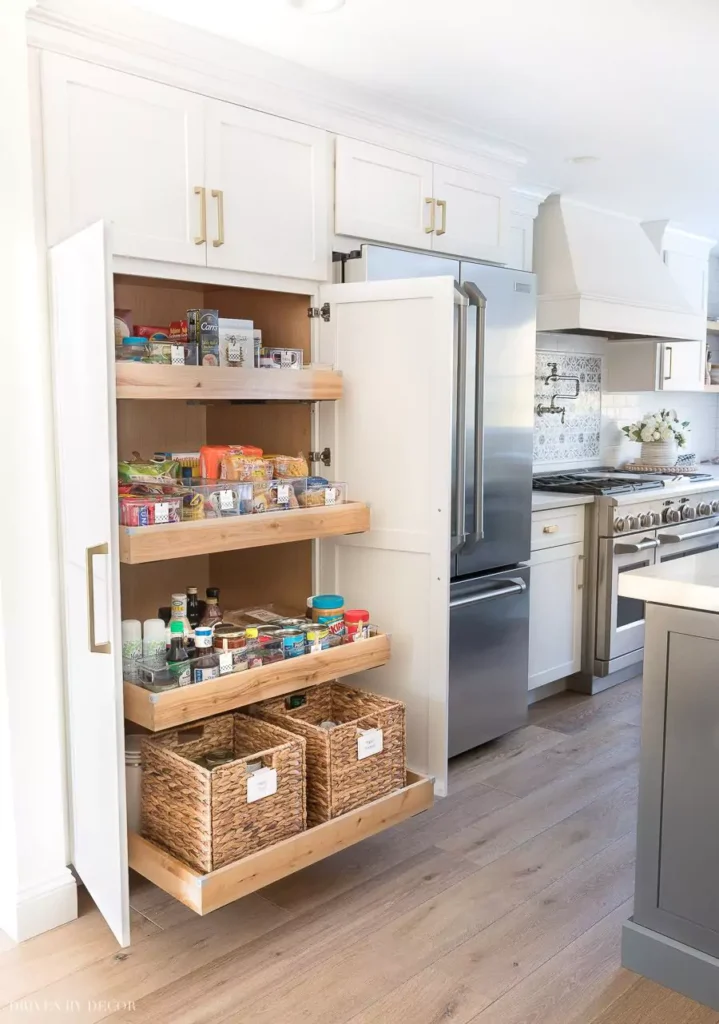
Replace traditional shelves with sliding drawers. According to BHG, sliding drawers make it easy to pull contents out for a “quick visual inventory”.
A drawer-heavy pantry might have deep drawers at the bottom (for canned goods, flour, large packages) and shallower pull-outs higher up (spices, snacks). Each drawer can be compartmentalized, so items don’t slide around.
This drawer-only idea maximizes accessibility, since you can see every item without reaching back. It’s especially useful in narrow pantries where bending and searching is difficult.
10. Mixed Cabinets and Shelving Pantry
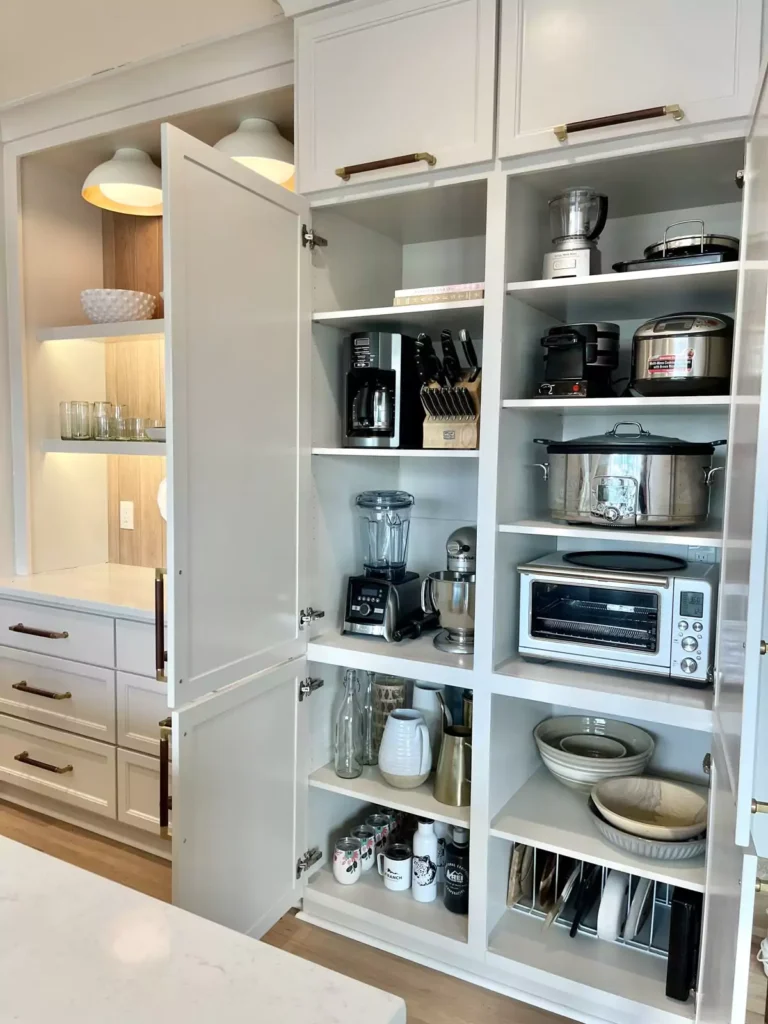
Combine cabinets, shelves, and drawers in one versatile layout. For example, one side could have closed cabinets for small appliances, another side open shelves for dry goods, and the center a counter with drawers below.
In one featured design, custom upper shelves held spices and dishes while deep drawers and cubbies below stored beverages and pantry items.
This mixed setup balances function and style: use glass-front cabinets for china, solid cabinets for messy items, and open shelves for pretty containers. The key is to define zones – e.g. one cabinet exclusively for baking supplies with labeled canisters, another with open jars for grains – to keep the system organized.
11. Corner Lazy Susan Pantry
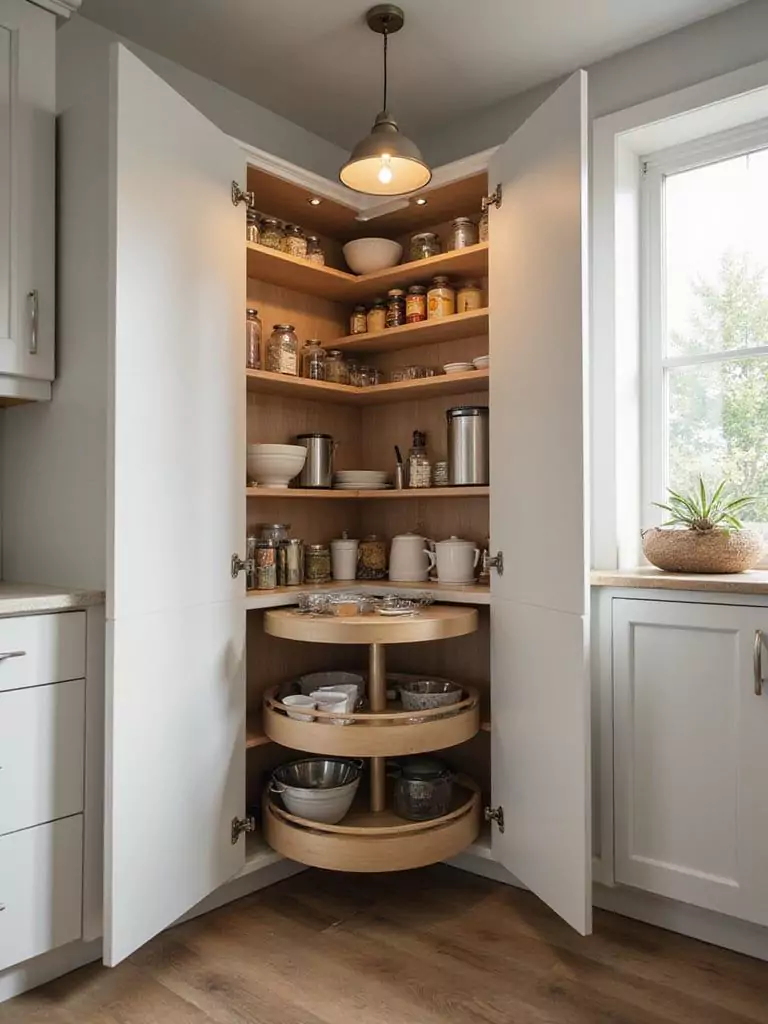
Fit rotating lazy Susan trays into corner shelf spaces. Lily Ann notes that lazy Susans (full- or half-circle) let you “access items…without the need to reach to the back of the pantry”.
Install a lazy Susan in a 90° corner to create a circular shelf surface. This is ideal for oils, spices, or canned goods that might otherwise hide in back. Mark the edges (e.g. “sauces” on one tray, “canned veggies” on another) to streamline retrieval.
Lazy Susans turn the dead corner into prime real estate and make even the hardest-to-reach items instantly visible.
12. Double-Door Pantry
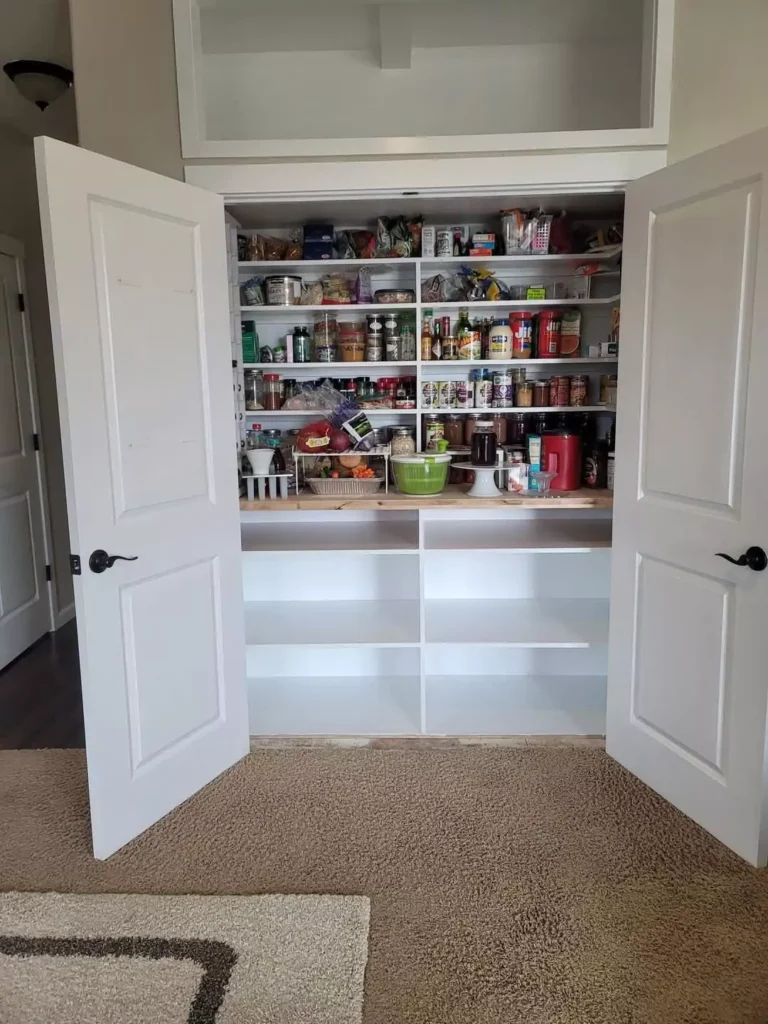
Use a wide double-door opening so you can pull open both sides of the pantry. BHG shows a floor-to-ceiling double-door pantry with adjustable shelving that easily handles tall bottles and boxes.
The large opening lets multiple people reach in at once, which is great for families. For example, one person can stock supplies on the left while another cooks on the right.
An organizational tip: add racks on the doors themselves for spices or canned drinks to double your storage. The symmetry of double doors also gives an elegant, built-in look.
13. Glass or Bold-Color Door Pantry
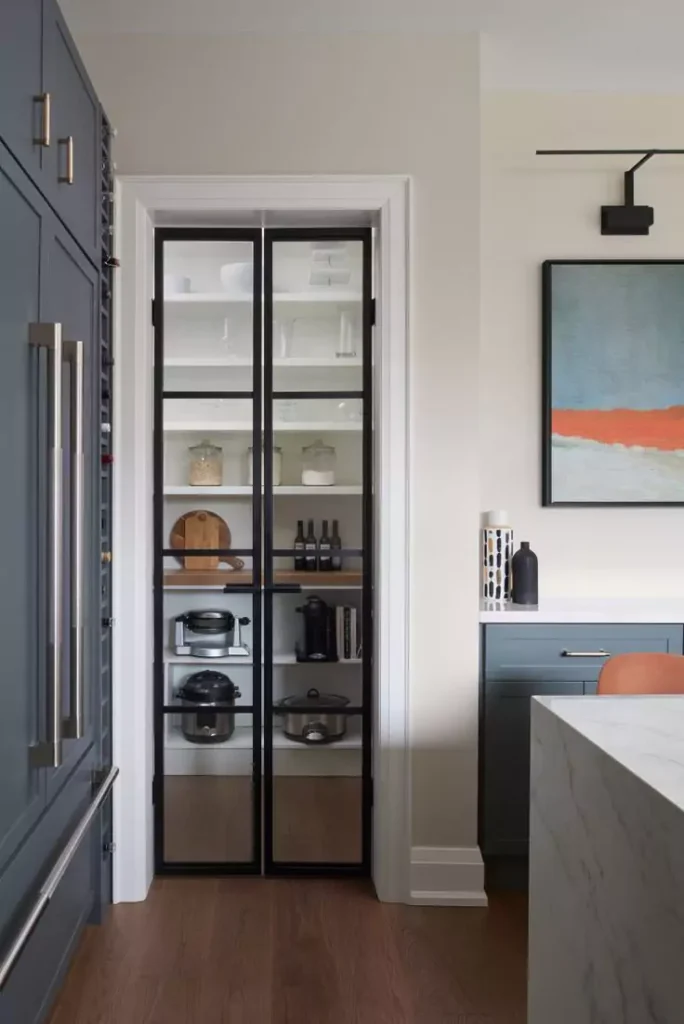
Make your pantry door a statement: use frosted glass or a pop of color.
A dark or bright door creates contrast and “adds a touch of elegance”. Glass (clear or frosted) lets you peek inside and, as House Beautiful advises, “keep[s] things visible” for easy access.
For example, black-framed glass doors suit modern or farmhouse kitchens, while a bright-painted door suits eclectic styles. Pair it with well-lit interiors so you can see contents behind the glass.
Even if fully closed, a striking door announces the pantry as a design feature.
14. Pocket Door Pantry
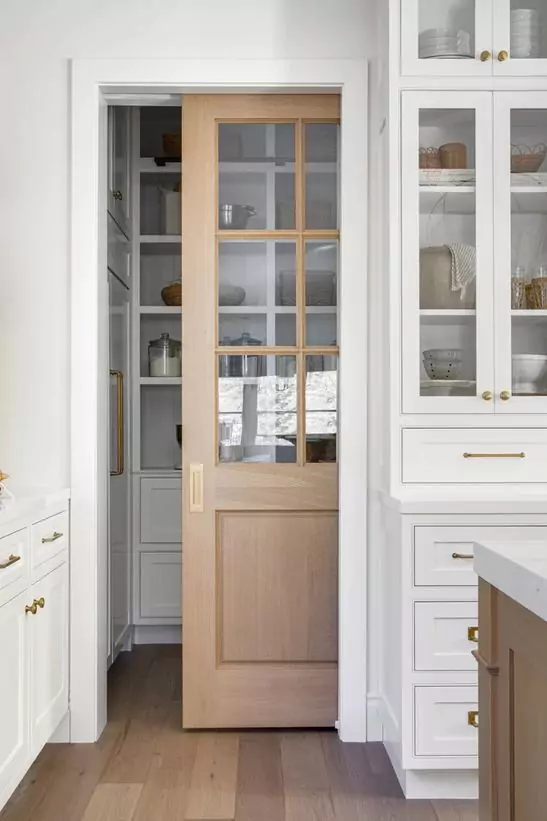
Install a pocket door that slides into the wall to save space.A pocket door as sliding into a hidden wall compartment, giving a “concealed storage area” when closed. You don’t have to worry about a door swinging out into a narrow kitchen.
Choose a door panel that complements your kitchen – for example, a barn-style pocket door or a mirrored panel to visually expand the space. Behind it, maximize every shelf height.
This door style keeps the pantry out of sight but easy to access, and it can make the pantry feel integrated with the room.
15. Mobile Cart Pantry
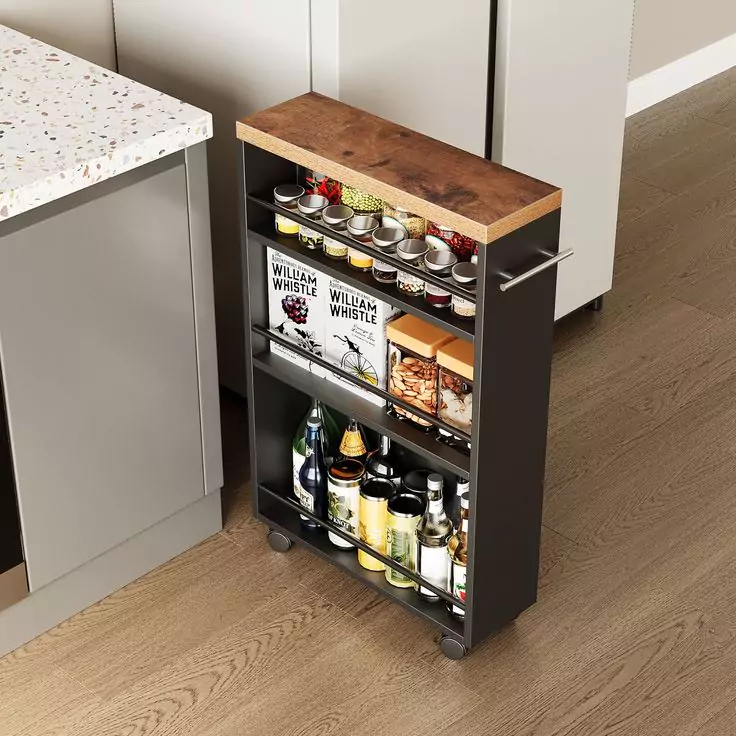
Add a wheeled cart or rolling island to increase flexible storage. As Lily Ann notes, a mobile cart can hold snacks, canned goods, or even serve as a beverage station.
When the pantry door is open, roll the cart partway out to reach its contents easily, then stow it back. Carts often have open shelves or drawers, so you can designate each level for a category (cereals, chips, drinks, etc.).
The portability means you can use it elsewhere in the kitchen too. Visually, a cart in a coordinating finish will tie in with your cabinetry, and functionally it adds extra counter space when needed.
16. Walk-In Pantry with Ladder
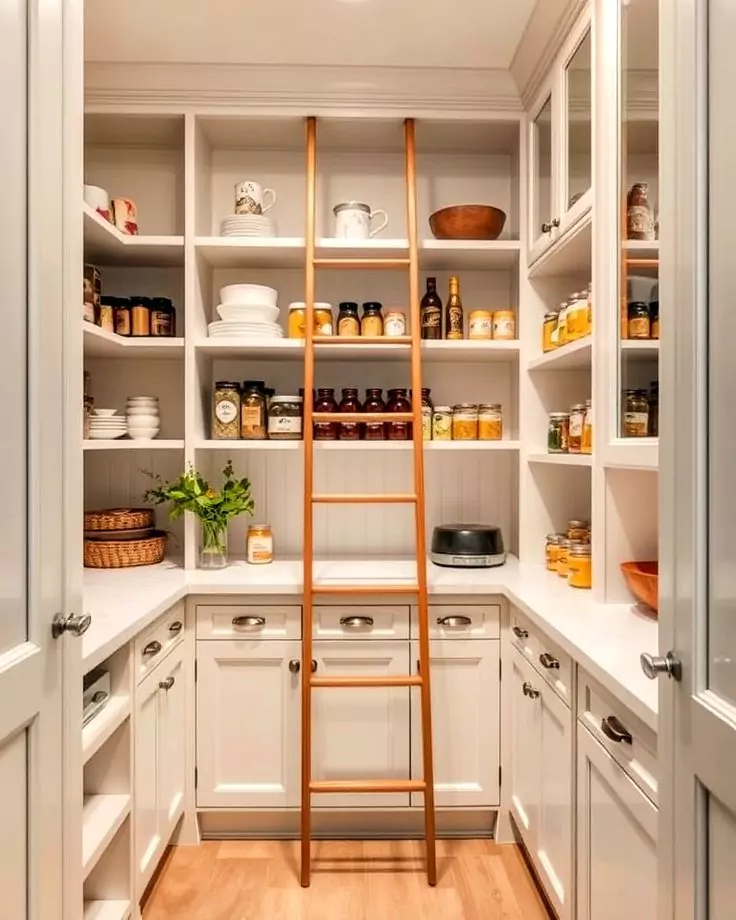
For tall pantry ceilings, a rolling or sliding ladder lets you use vertical space safely.A pantry with a sliding ladder “optimizes vertical space” and becomes a stylish focal point. Install rails and a ladder on one wall.
Then you can reach the top shelves (great for those rarely-used holiday items). Choose a ladder finish to match – a sleek metal ladder for modern pantries, or a wood ladder for a traditional look.
Ensure the lighting is bright on each shelf so climbing up/down is safe. The ladder also adds an upscale, library-like touch.
17. Butler’s Pantry with Wine Fridge
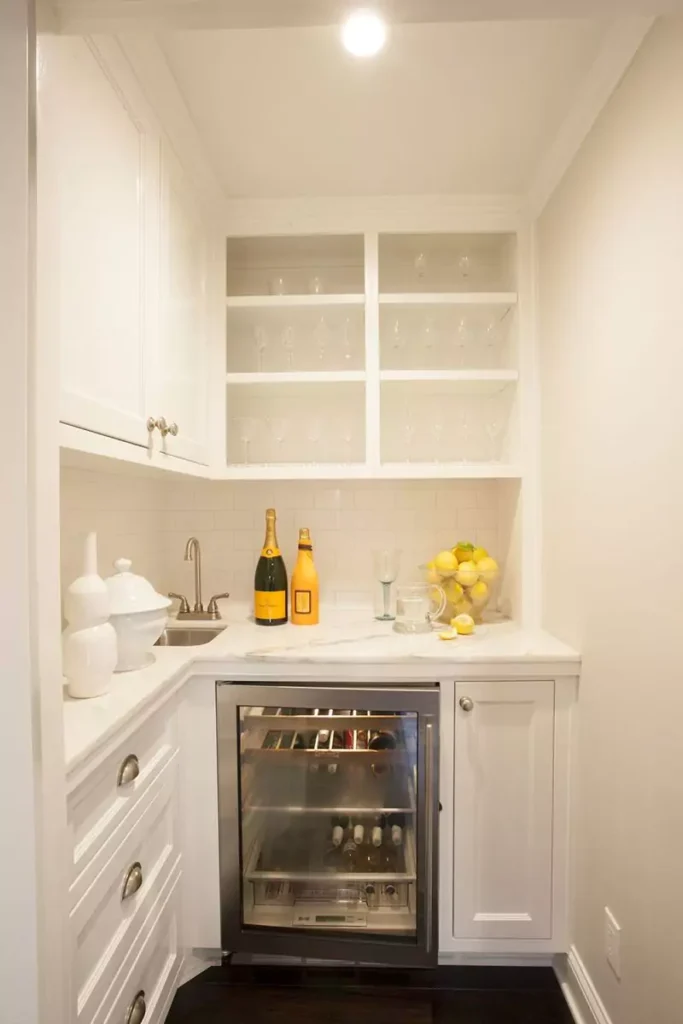
Create a pantry-inspired butler’s pantry by adding a small fridge or wine cooler.
A “luxurious and practical” addition. In a small walk-in pantry, a countertop could hold a coffee maker or liquor decanter, with a mini-fridge underneath for drinks. Use upper cabinets or open shelves for glassware and serving pieces.
This hybrid space serves both storage and prep: designate one zone for snacks and one for beverages. The result is elegant (perfect for entertaining) and ultra-functional. As a tip, keep serving trays and plates near the drink fridge so everything for a party is in one place.
18. Industrial Style Pantry
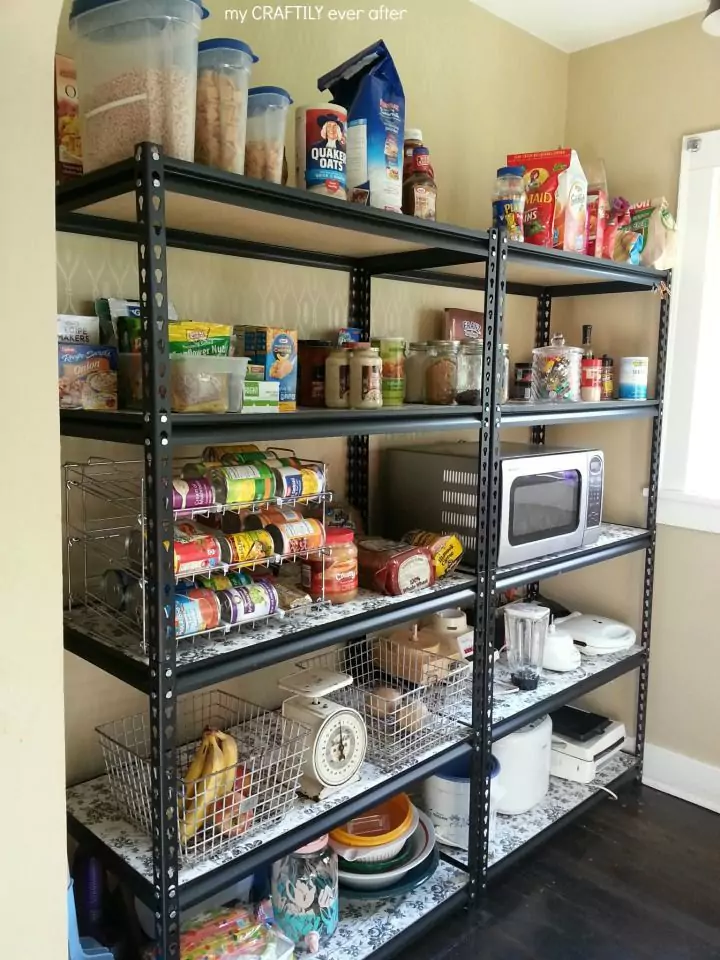
Go for an industrial look with metal accents and open frameworks. I suggest raw materials and utilitarian elements: use metal shelving units, exposed hardware, and wire baskets to create an “edgy vibe”.
For example, black steel frames and reclaimed wood shelves look rugged yet modern. Metal baskets or bins are practical for bulk storage and add to the industrial charm.
Balance the look with some warmth: a wood countertop or warm LED lighting. This style combines function and flair – perfect for a loft or urban kitchen theme.
19. Minimalist White Pantry
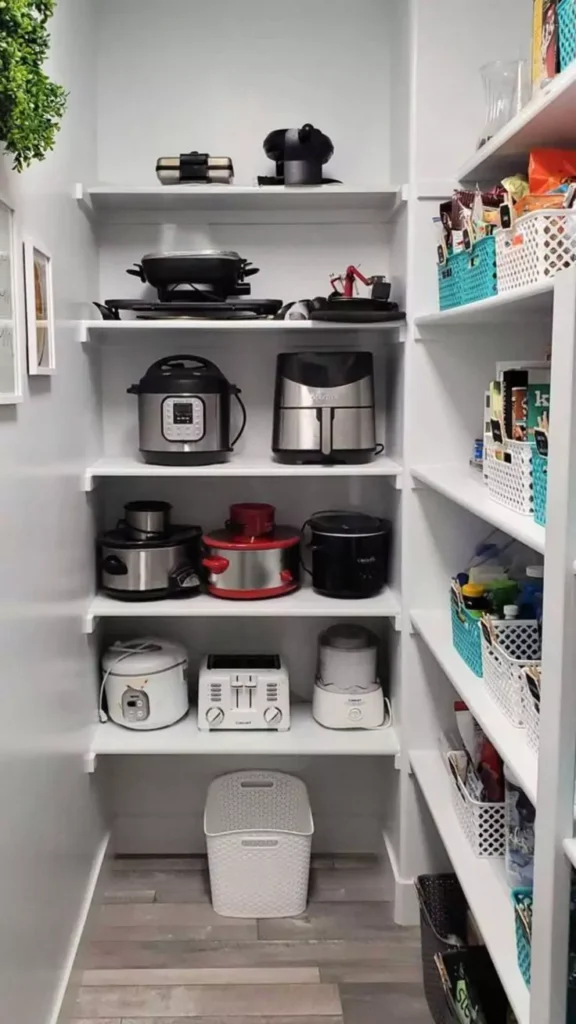
A minimalist all-white design makes the space feel larger and ultra-clean. BHG points out that white shelving “boosts brightness” in a small pantry. Keep cabinet fronts flat and handleless, or use simple hardware, for a streamlined look.
On the shelves, use clear or matching white containers so everything looks uniform.
Even small items like spice jars can be in matching glass tins. The uniform palette eliminates visual clutter. Bright task lighting (see below) further enhances the minimalist feel by illuminating every corner.
20. Over-the-Door Organizers
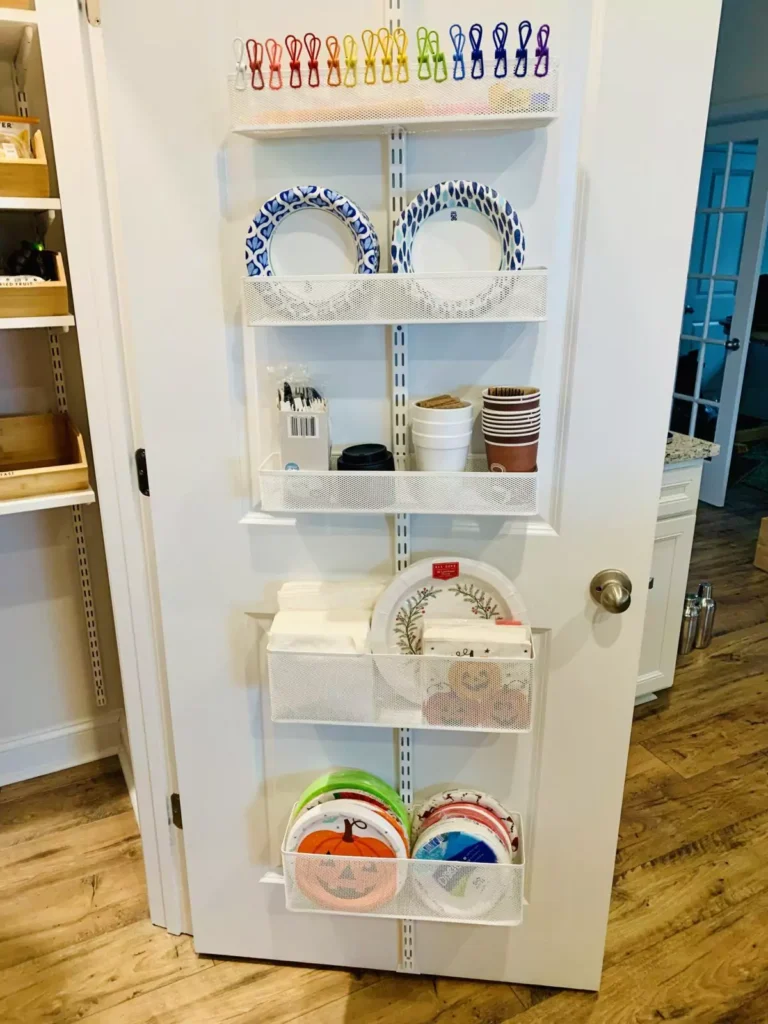
Maximize unused door space with hanging organizers. Install racks, hooks, or pocket organizers on the inside of the pantry door (or cabinet doors) to hold oils, spices, condiments or cleaning brushes.
I personally recommends these over-the-door solutions for small items that would otherwise clutter shelves. For instance, a narrow rack can hold foil, wraps, or wine bottles. Similarly, magnetic strips on the door can hold knives or spice jars.
The trick is to keep the door contents organized – group like items together – so opening the pantry immediately reveals as much usable space as possible.
21. Zone-Organized Pantry
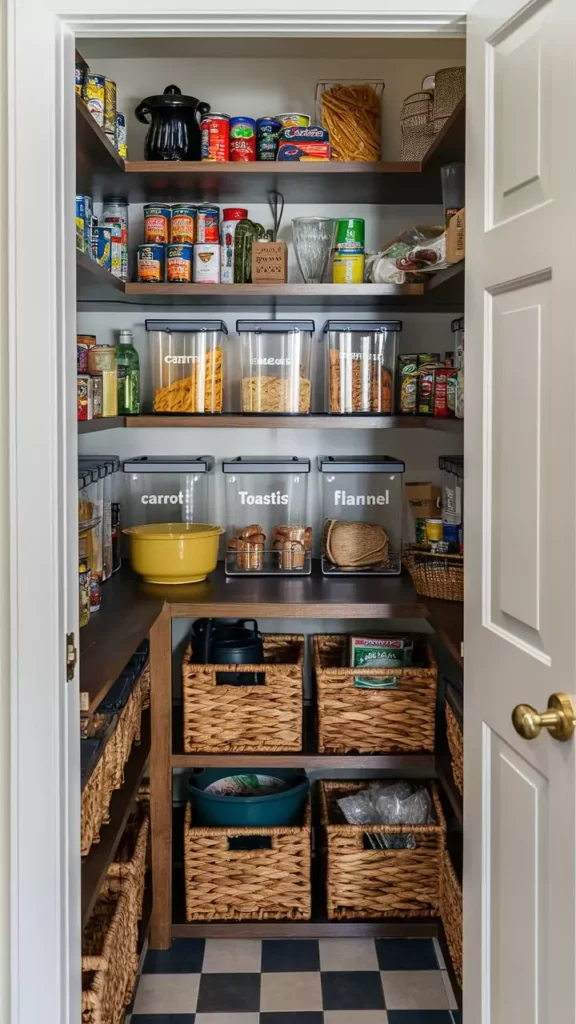
Divide the pantry into purpose-based zones. BHG advises grouping foods (breakfast, snacks, dinner ingredients, etc.) on separate shelves. Label each shelf or container clearly so everyone knows where things go.
For example, one shelf can be “cereal & grains”, another “canned goods”, and a bin labeled “baking supplies”. Use matching bins within each zone to corral smaller items (lid under one, seasoning packets in another).
This system prevents chaos: when groceries are put away correctly, you’ll always know where to find each category, and it’s easy to keep the pantry looking neat.
22. Well-Lit Pantry
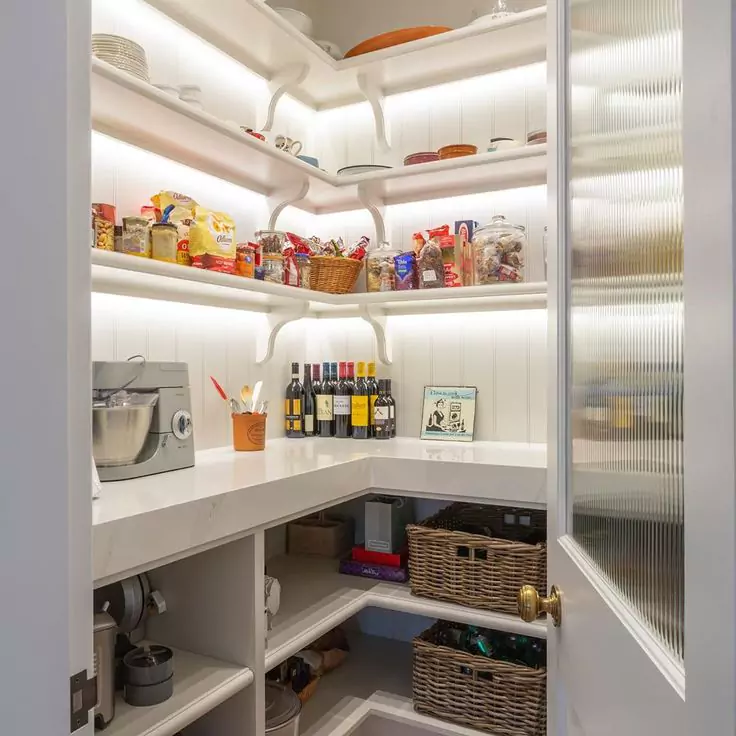
Install good lighting to make every shelf visible. According to House Beautiful, pantries “tend to be dark and cramped,” so adding task lighting means “each shelf can be seen easily”.
Use LED strip lights under each shelf or a ceiling light deep in the pantry. Even a small frosted window or glass door can bring daylight in.
Adequate lighting not only prevents overlooked items and spills but also enhances the design (bright spaces look bigger). For aesthetics, consider warm-tone bulbs in a decorative fixture or cool daylight LEDs for a crisp look.
23. Cubby-Style Pantry
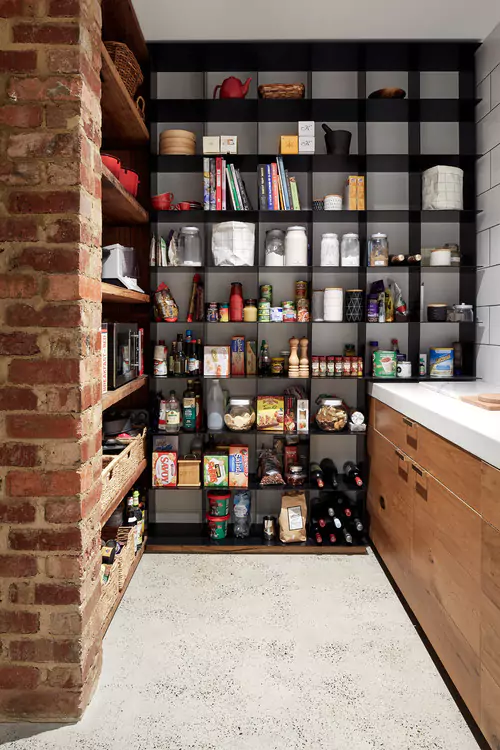
Arrange the pantry as a wall of cubbies or pull-out boxes. In a cubby design, each box or bin is dedicated to one type of itembhg.com. BHG describes it as cabinets fitting together in a “cubby-style” layout with room for both bulk and everyday items.
For example, a deep bin might hold potatoes, a stackable crate for snack pouches, and smaller drawers for linens or pet food. Label each cubby prominently.
This approach is great for hands-off sorting (grab a crate, take it to the counter, and return it) and helps everyone in the household grab only what they need.
1. How to maximize storage in a small pantry?
Maximize vertical space: Install adjustable shelves from floor to ceiling to use every inch. Store infrequently used items up high and keep daily items within easy reach.
Install pull-out organizers: Use pull-out drawers or rotating Lazy Susans in deep cabinets. These allow you to see and reach cans or jars in back without creating clutter.
Decant and consolidate: Remove bulky cardboard packaging and transfer dry goods into uniform, clear containers or bins. This creates a neater look, saves space, and lets you quickly see how much you have. Stack containers whenever possible to use full shelf height.
Use hidden spaces: Mount slim racks or baskets on the inside of doors (or walls) to hold spices, wraps, or small items. You can even affix dowel rods for bottles or utensils. Also, stack cans vertically and use shelf risers so nothing is hidden at the back.
2. What can I use instead of a pantry in a small space?
Pantry Cabinet or Closet: A tall kitchen cabinet (built-in or freestanding) can serve as your “pantry.” Use pull-out shelves, bins, or lazy Susans inside it to organize food. Even repurposing a small closet or deep drawer for food storage works great.
Free-standing Furniture: Consider a buffet, hutch, or even a bookcase in or near the kitchen as extra storage. A simple bookcase with baskets or a wine cabinet can hold canned goods, pasta, and snacks.
Open Shelving/Wall Storage: Install shelves on empty kitchen walls for jars and cookbooks. Adding hooks or rails under shelves can hang utensils, tea towels, or mugs, freeing cabinet space for pantry items.
Alternate Nooks: Look for unused nooks (e.g. a narrow alcove, under-stair closet, or hallway cupboard). Transforming an adjacent pantry space (like a butler’s pantry) or customizing an odd corner next to the fridge can give you pantry-style storage without eating up kitchen floor space.
3. What is the smallest size for a walk-in pantry?
A true walk-in pantry typically requires at least a 5 ft by 5 ft footprint. This size allows shelves on either side and a 36-inch-wide aisle so you can comfortably step inside. In practice, many designers say you need a minimum 36″ of clear walkway for one person to move and grab items. (Anything smaller and it starts to function more like a reach-in closet than a walk-in space.)
4. What should not be stored in a pantry?
Highly perishable foods: Don’t keep meats, seafood, dairy products, or eggs in the pantry – these belong in the fridge/freezer. Likewise, fruits and vegetables that spoil quickly (like melons, citrus, root veggies) should stay chilled.
Hazardous items: Keep cleaning supplies, pesticides, batteries or other chemicals out of the pantry. Storing cleaners or non-food items with food risks contamination and is unsafe.
Pet food: Even in sealed containers, pet food can attract pests and odors. It’s best kept in a separate area (like a laundry room or mudroom).
Open/unprotected dry goods: Don’t leave grains, flour, cereals, or chips in open bags – always use airtight containers or bags. Whole-grain flours and nuts, in particular, go rancid at room temperature and should be refrigerated if you buy in bulk.
Expired or unwanted food: Regularly clear out anything past its prime. Forgotten old cans or boxes take up space and should be discarded or donated.
5. Does a walk-in pantry need a door?
A door isn’t strictly required, but it does have advantages. With a door: you can hide clutter from view and keep insects, dust, and heat out of the pantry.
A closed door also helps maintain a cool, dark environment for food. Without a door: the space feels more open and bright, which can be handy in a very small kitchen.
Better Homes & Gardens notes that removing the pantry door (or using a sliding door) can make a cramped kitchen feel airier and allow easier access. In short, use a door if you want to conceal the pantry or control temperature; skip it if you prefer openness and always keep the shelves neat.
6. What are the must-haves in the pantry?
Adjustable shelving: Sturdy, adjustable shelves (ideally floor-to-ceiling) are essential so you can customize space for tall bottles, cereal boxes, or small jars. High shelves can store items you use infrequently.
Good lighting and outlets: Pantries need good light. Install overhead or under-shelf lighting so you can easily find things. If you plan to keep any small appliances (coffee maker, toaster, blender) in the pantry, include an electrical outlet for convenience.
Uniform, labeled containers: Use matching clear containers and baskets to corral bulk foods (flour, rice, cereal, snacks). Label everything (even the baskets) so you immediately know what’s inside. This not only looks tidy but prevents forgotten expired items.
Organizational accessories: Spice racks, pull-out baskets, tiered risers, and lazy Susans are pantry must-haves. They make small items easy to reach and keep categories (spices, snacks, baking mixes) sorted. Don’t forget a sturdy step stool if you have high shelves.
Pantry staples: Stock basic ingredients so you always have what you need for cooking. For example, keep flour, sugar, oils, vinegars, canned tomatoes, beans, rice, and a range of spices on hand. Having these basics means your pantry really serves your kitchen needs.
7. Should bananas be stored in the pantry?
Yes – bananas do fine at room temperature, so a cool, dry pantry or cupboard is a good spot until they ripen. Experts advise keeping bananas out of direct sunlight and away from heat sources (don’t put them on a sunny counter or above a hot oven).
A pantry cabinet usually stays darker and cooler, which helps the bananas last a bit longer.
Once the bananas reach full ripeness, you can refrigerate them to slow further ripening (the peels will darken in the fridge, but the fruit inside stays firm a few days longer).
In summary: store unripe bananas at room temperature (pantry is fine), and move them to the fridge only after they turn fully yellow to extend freshness.
8. What is an alternative to a walk-in pantry?
A good alternative is a pantry cabinet: a tall, closet-like cabinet with shelves built into your kitchen. This can be custom cabinetry or a free-standing pantry unit.
It provides storage almost as well as a walk-in, but takes up much less floor space. Other options include a butler’s pantry (a small prep/storage zone adjacent to the kitchen), or even adding a large buffet or hutch with storage.
Some people convert a nearby closet or nook (hallway closet, mudroom, under-stair space) into pantry shelves for overflow. For very tight layouts, a narrow pull-out pantry cabinet or wall shelves (with labeled jars) can also serve in lieu of a full walk-in.
The idea is to adapt any available area (cabinet, shelf, closet) to hold your dry goods when you can’t add a dedicated walk-in room.
9. How to organize a small pantry?
Group and label: Start by sorting your food into categories (baking, grains, snacks, etc.) and toss any expired items. Transfer loose items into clear jars or baskets so they’re easy to grab. For example, put all snack bars or chips into labeled bins, and keep pasta and rice in clear containers. Well-labeled storage instantly cuts down visual clutter.
Stack and use vertical space: Arrange goods so you use every inch. Stack cans and boxes vertically, or file cereal boxes like files so you can pull what you need. Keep frequently used items at eye level. Use shelf risers or baskets to create layers on each shelf.
Use door and wall space: Hang a spice rack or small baskets on the inside of the pantry door to hold spices, oils, or cleaning wraps. This takes advantage of space that would otherwise be dead. You can also mount hooks on side walls for aprons or tools.
Keep it accessible: Store everyday items (snacks, breakfast foods) at kid-eye level if you want little ones to help themselves safely. Reserve top shelves for things you rarely need. If you do have high shelves, keep a sturdy step stool handy inside the pantry.
Finishing touches: A consistent look helps too. Use matching baskets or containers for non-food items (napkins, paper towels) and keep cleaning supplies (broom, vacuum) just outside the pantry for crumbs. With everything visible and categorized, even a tiny pantry can feel spacious and efficient.

